
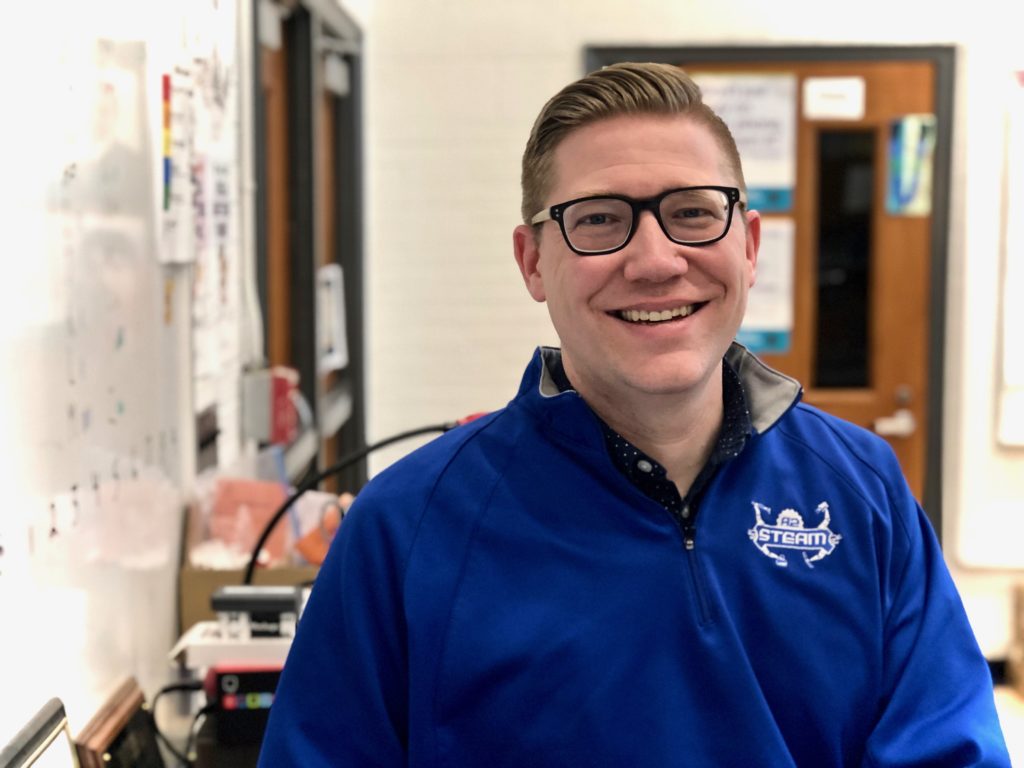
Photos & video by Jo Mathis/AAPS District News Editor
Bill Van Loo is a maker, teacher, musician, and photographer. He grew up in Jackson County and graduated from Napoleon High School. Both of his parents were educators; his father was a high school science teacher, and his mother was a librarian. Even with both of them working in education, Van Loo never thought of teaching as a career path until much later in life.
Van Loo earned a bachelor’s degree in Scientific and Technical Communication from Michigan Technological University in 1997. During his time at Michigan Tech, he took an internship working for a startup company in downtown Detroit that worked in the then-new field of web development. After finishing his degree, he returned to that company, and worked in web development for eight years, including programming, interaction design, project management, and software testing. Switching careers in 2005, he returned to school, earning a post-baccalaureate teaching certificate in Technology & Design Education from Eastern Michigan University in 2007, and following that up with a master’s degree in Educational Media & Technology from EMU in 2016.
Upon earning his teaching certificate, Van Loo served as the technology specialist for Honey Creek Community School, a public charter school in Washtenaw County. This role was split between classroom instruction and working as the school’s technology director, including planning and strategy, technical support, and technology integration. He joined AAPS in 2014 as the Technology & Engineering teacher for the then-new A2 STEAM program.
Van Loo lives in Ypsilanti with his wife, Sarah, who is also a Project Lead the Way teacher for AAPS. Their three children have all attended AAPS, with Collin graduating from Skyline in 2017, and Aidan and Hannah attending Skyline currently. When not teaching, Van Loo focuses on his passion areas of music, photography, and making things, working at the intersection of art, design, and technology.
What is your fondest memory so far of teaching at A2 STEAM? I have so many great memories from my time at A2 STEAM. Walking into the building for the first time in the summer of 2014 stands out; we had a brief walkthrough while the building was still under major renovation, and you could just feel the potential there. For me, getting that first glimpse of what would become my teaching space for the first two years of A2 STEAM (the room that now serves as our building’s Makerspace) was so exciting; it was literally a bare concrete room at the time, but I knew it would become something amazing.
What inspired you to become a teacher? When I was still working in web development, I had thoughts of retiring from business at the end of my career and finishing out my working life by teaching. My wife, however, wisely suggested that it would be great to see me more often, due to the long hours I was working, and suggested I think about switching careers earlier. I took her advice, and I’m so happy I did! Looking back, I realize that I had many precursors to teaching, including working in the Writing Center at Michigan Tech, and serving as a computer lab consultant, helping users with using software and solving problems. I also taught a semester-long class in sound design at College for Creative Studies in Detroit, which really helped me realize that I loved teaching.
What’s the best compliment anyone could give you? I love to hear that I inspired someone to try something new, and gave them the confidence to try it. This could happen in my roles as a classroom teacher, professional development facilitator, or curriculum developer, and with students or adults; it’s all the same thrill. It’s especially wonderful hearing this long after I’ve forgotten about the interaction. The fact that an idea or technique I taught is personally meaningful, relevant, and empowering to someone else is the reason I do what I do.
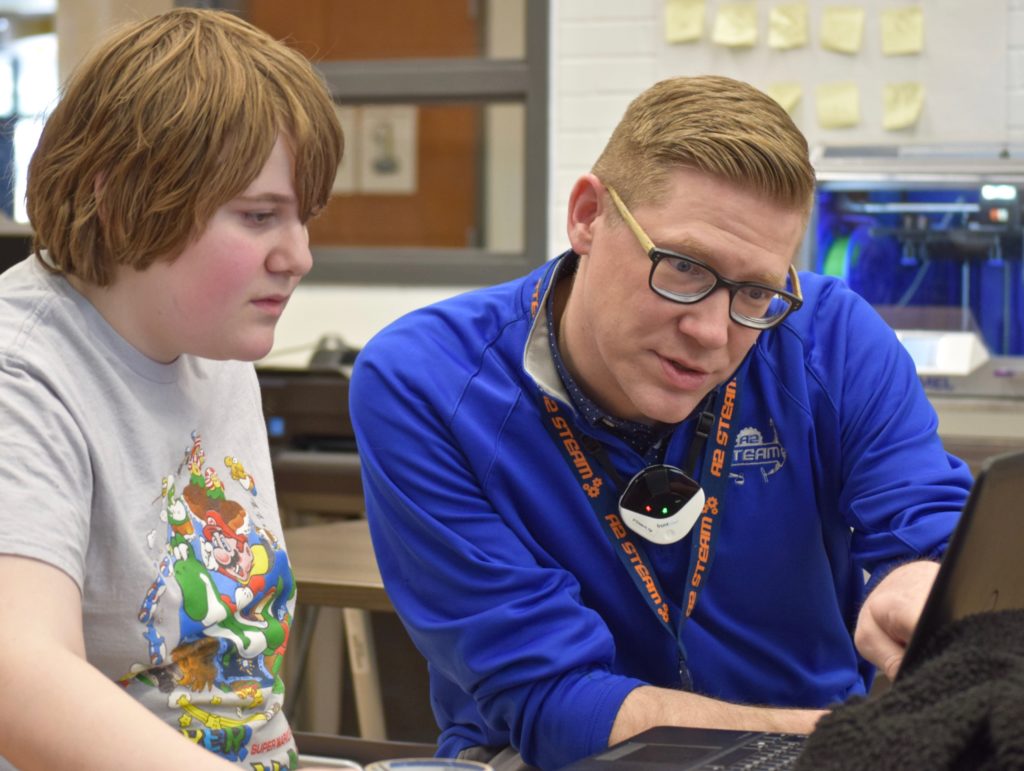
In which other teacher’s classroom would you like to enroll for a day? Why? I was double-promoted from fourth grade to sixth grade in my childhood (which had its share of positives and drawbacks), so I’d love to enroll in my colleague Brandon Vince’s 5th grade classroom at A2 STEAM to see what I missed! Brandon and the 5th grade team do amazing things with their students, including raising salmon, building chicken coops, and re-enacting the revolutionary war.
In your five years in AAPS, what’s the most important thing you’ve learned about teaching? About learning? In my five years in AAPS (12 years teaching total), the most important thing I’ve learned about teaching is to lead with empathy and build relationships with students. Reading several of the Love & Logic books during my pre-service planted this in my mind, and having the opportunity to do my student teaching with Tom Pachera at Forsythe Middle School cemented this even further – he is a master at building relationships with both students and adults. Without empathy and relationships, it doesn’t matter how much you know about your content.
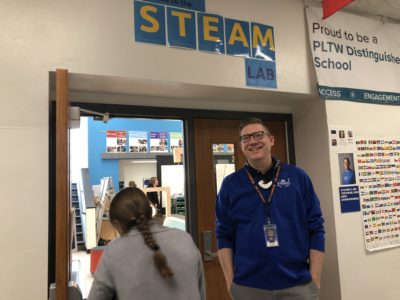
What do you love about Project Lead the Way? And how did you feel to be named a national Project Lead the Way Teacher of the Year finalist? I love the fact that Project Lead the Way gives teachers across the country a consistent framework for high-quality project-based learning, and provides both the curriculum and the professional development to make it successful. I work as a Master Teacher for PLTW during the summer, training other teachers, and I love the opportunity to reflect on my own teaching practice during this time as well as the chance to empower more teachers to broaden their perspective.
During my own PLTW courses, I consistently see students deeply engaged in their project work, to the point where I often have to kick them out of the room at the end of passing time! That’s a simple heuristic that points to the fact that students are personally committed to what they’re doing. I also love seeing the way students take the knowledge and skills they gain through PLTW courses and apply it other areas of their learning. I think A2 STEAM provides a special opportunity for this kind of knowledge transfer, since so much of our work is project based.
Being named a PLTW Gateway Outstanding Teacher points back to the incredible team that AAPS has assembled in our PLTW teachers. Without the team’s hard work to nominate me, gather the necessary documentation and recommendations, and see the process through, I wouldn’t have had that opportunity, and I’m grateful to all of them. I see the award as a reflection of our team’s success.
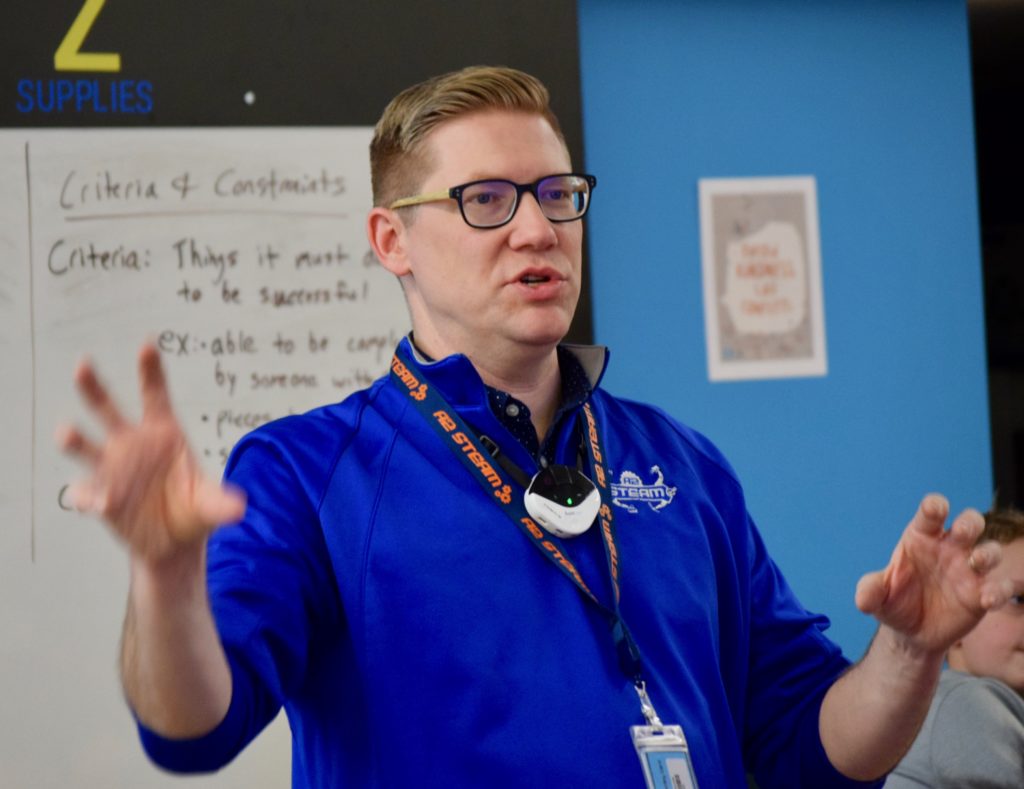
What advice would you give to a first-year teacher? My advice to teachers, whether first year or veterans, is always the same: when you’re trying something new, start small, and start with something you’re passionate about. If you’re thinking of trying out the idea of adding a Makerspace to your school or classroom, don’t think you have to go out and buy a 3D printer – start with cardboard and duct tape! If you’re thinking of trying out project-based learning, pick a topic you love and can connect with students about.
Describe an average workday. On a normal day, I drop my kids off at Skyline, and head back up M-14 to A2 STEAM. I spend the first 20 minutes of my day doing bus duty outside, welcoming students to the new school day and helping keep them safe and happy. I’m lucky enough to have a morning prep 1st period, where I send email, do grading, meet with staff about special education follow up, and whatever else I can cram into that time – it goes by quickly! After bus duty, fellow A2 STEAM staffers know I’m headed to the lounge to grab the day’s second cup of coffee.
Starting 2nd period, my teaching day begins. Each day, I teach 4 middle school courses: Computer Science for Innovators & Makers, Automation & Robotics, Energy and the Environment, and Design & Modeling. I also teach a section of 5th grade technology and engineering. Depending on the day of week, the rest of my afternoon is spent in team meetings, project-based learning planning sessions, providing support for my middle school PLTW colleagues across the district, or working on STEAM Lab projects. After the school day is wrapped up, it could be time for a staff meeting, middle school robotics team practice, equity meeting, or other district work, such as the STEAM PLC.
What do you eat for lunch, and where? I tend to stick to vegetarian meals from Costco or Trader Joe’s—lots of Indian food packets and microwave rice. If I’m splurging, I might order from Panera. I try to mix up where I eat, sometimes inviting students into the lab to catch up on missing work, sometimes eating in the staff lounge with colleagues, and sometimes upstairs to the middle school wing to have collegial conversation or check in about students of concern.
What makes a good day at school? The best kind of school day is when I’m finally able to find the thing that lights up a student’s interest. I experience it again and again: students who are only marginally interested finally come upon that one thing, and all of a sudden they’re hooked. The magical part is that it’s often wildly different things that grab them; for some students, it’s being taught how to use a new tool in the lab, like the vinyl cutter or 3D printer. For others, it’s being told that it’s OK to inject their creativity and humor into a video they make for their project documentation – in fact, it’s encouraged! Seeing students click with something and knowing they’re truly bought it in make it all worthwhile.
Apps you can’t live without: As someone with ADHD, I find that my phone is both my biggest help, and often my biggest distraction. One of the things that keeps me pointed in the right direction is Evernote, which sort of serves as my external brain; it’s a highly optimized tool for keeping notes. I use Fantastical as my calendar, and it defines what David Allen calls the “hard landscape” of your day. I’m a “Getting Things Done” advocate, though I can’t say I follow all his practices. Google Classroom has been a great resource for curriculum planning, blended learning, and providing feedback for students; the fact that I can use my phone to check in when I’m away from the building makes it even more powerful.
I think Twitter may be the best professional learning network in existence; I’ve learned an incredible amount from educators, academics, community organizers, and advocates across the globe over the 8 years I’ve been active (@billvanlooteach). During downtime, YouTube, Podcasts, and Spotify are my go-to apps.
What do you know about teaching now that you wish you’d known that first year? Don’t engage students in power struggles. Ask “how can I help” and “what do you need” before you rush to judgment and consequences. As I continue to learn more about trauma-informed education, these lessons keep getting reinforced in deeper and deeper ways.
How do you show school spirit? I love the fact that I’m part of two amazing teams in AAPS: our building staff at A2 STEAM, and our PLTW team, which is spread across the district. A2 STEAM has a staff that will take on any challenge and run with it; there’s nothing like working in a building under near-constant construction for 2 solid years to bring a group together! We love spreading our enthusiasm through spirit week, school t-shirts, and fun contests like our “penny wars.”
The PLTW team gets to build our relationships and team spirit through our PLC, road trips to conferences, social gatherings, and cheering each other on in our endeavours such as robotics competitions and the district-wide STEAM Expo.
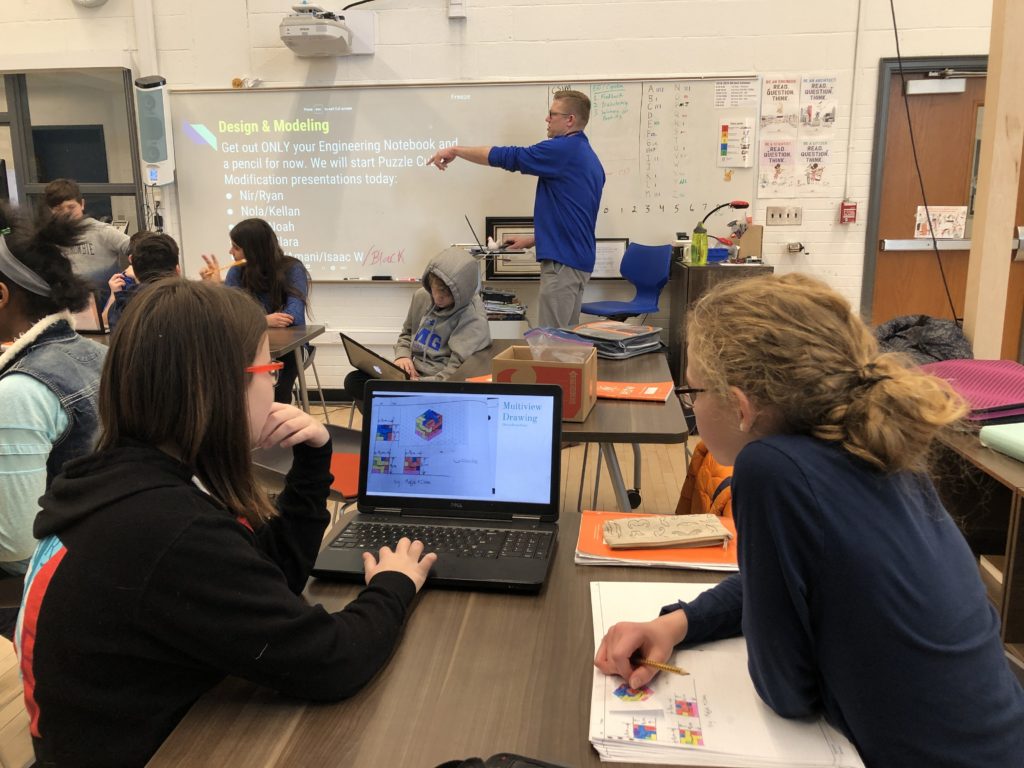
What is the most rewarding part of teaching? For me, the most rewarding part of teaching is knowing that you’re making a positive difference in someone’s life. It’s the reason I switched into education in the first place, and it continues to hold true. The positive difference may not even be what you’re teaching them – it may be the relationship you’ve built, or the atmosphere of our classroom, or the trust they feel in you.
How do you recharge? I recharge by digging into my passion areas and trying to practice a little self-care. For me, that means making things in my home workshop, playing and recording music, spending time with my family, and being part of my church community at Grace Ann Arbor.
How do you spend your summers? For the past three summers, I’ve had the opportunity to work as a Master Teaching for PLTW. I love the chance to travel across the country and teach other teachers.
I am also active in North Coast Modular Collective, which is a group of likeminded artists, musicians, makers, and coders. We design and build electronic synthesizer modules, play and record music, and host community events. Summers are prime time for this work; I host a 3-day “Summer Camp” where we gather at my house to solder parts together, make music, and share in our super nerdy passion for electronic music and tools.
Most importantly, I also take time in the summers to travel with my family, occasionally sleep in, and have coffee dates on the front porch with my wife.
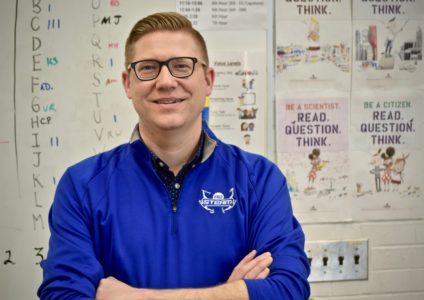
What’s most exciting about your professional life right now? Your personal life? The most exciting thing in my professional life right now is seeing how things have developed so far at A2 STEAM and with PLTW, and being part of the teams that are continuing to think about what’s next. That means lots of work on things like grant writing, curriculum development, vision and strategy planning, and professional development.
In my personal life, I am really excited to see where North Coast Modular Collective will go in the next year or two. Being part of the group has given me an opportunity to bring together a number of things I’m passionate about: designing instruments, making music, and building a community of electronic musicians.
How do you think students will remember you and your class? I hope that students will remember my class as a school experience where they got to exercise their individual agency, learn new skills and knowledge that they put to use later in life, and build a set of positive relationships. I can’t wait to see what my students do in the future.

Be the first to comment